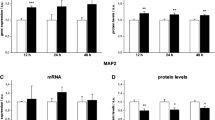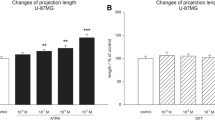Abstract
Aim of the present study was to evaluate effects of ligands of oxytocin receptors on gene expression of neurofilament proteins (nestin and microtubule-associated protein 2 (MAP2)) associated with neuronal differentiation and growth factors (brain-derived neurotrophic factor (BDNF) and nerve growth factor (NGF)) related to neuronal growth. Fluorescent staining of F-actin was used to observe morphology of cells. Co-treatment with oxytocin and oxytocin receptor antagonist—atosiban—resulted in significant increase of MAP2 gene expression in SK-N-SH cells. There was no effect of oxytocin on gene expression of growth factors BDNF and NGF. Surprisingly, oxytocin with atosiban significantly increased mRNA levels for both BDNF and NGF. Gene expression of vasopressin receptor (V1aR) significantly decreased in response to vasopressin. Atosiban decreased mRNA levels for oxytocin receptor (OXTR) and V1aR. Oxytocin significantly decreased OXTR and nestin mRNA levels and increased mRNA levels for BDNF and NGF in U-87 MG cells. The densest recruitment of F-actin filaments was observed in apical parts of filopodia in SK-N-SH cells incubated in oxytocin presence. Present data demonstrate complex role of ligands of oxytocin receptors in regulation of gene expression of intermediate filaments and thus, oxytocin might be considered as a growth factor in neuronal type of cells.



Similar content being viewed by others
References
Alderson RF, Alterman AL, Barde YA, Lindsay RM (1990) Brain-derived neurotrophic factor increases survival and differentiated functions of rat septal cholinergic neurons in culture. Neuron 5(3):297–306
Bakos J, Strbak V, Ratulovska N, Bacova Z (2012) Effect of oxytocin on neuroblastoma cell viability and growth. Cell Mol Neurobiol 32(5):891–896
Bosch OJ, Neumann ID (2012) Both oxytocin and vasopressin are mediators of maternal care and aggression in rodents: from central release to sites of action. Horm Behav 61(3):293–303
Briner VA, Tsai P, Choong HL, Schrier RW (1992) Comparative effects of arginine vasopressin and oxytocin in cell culture systems. Am J Physiol 263(2 Pt 2):F222–F227
Cassoni P, Marrocco T, Bussolati B et al (2006) Oxytocin induces proliferation and migration in immortalized human dermal microvascular endothelial cells and human breast tumor-derived endothelial cells. Mol Cancer Res 4(6):351–359
Che T, Sun H, Li J et al (2012) Oxytocin hyperpolarizes cultured duodenum myenteric intrinsic primary afferent neurons by opening BK(Ca) channels through IP3 pathway. J Neurochem 121(4):516–525
Choi SA, Hwang SK, Wang KC et al (2011) Therapeutic efficacy and safety of TRAIL-producing human adipose tissue-derived mesenchymal stem cells against experimental brainstem glioma. Neuro-Oncology 13(1):61–69
Croci T, Cecchi R, Marini P et al (2007) In vitro and in vivo pharmacological characterization ofethyl-4-[trans-4-[((2S)-2-hydroxy-3-[4-hydroxy-3[(methylsulfonyl)amino]-phenoxy]propyl) amino]cyclohexyl]benzoate hydrochloride (SAR150640), a new potent and selective human beta3-adrenoceptor agonist for the treatment of preterm labor. J Pharmacol Exp Ther 321(3):1118–1126
de Wit NC, Heck AJ, Thornton S (2010) The effect of oxytocin and an oxytocin antagonist on the human myometrial proteome. Reprod Sci 17(1):40–46
Finger EC (2011) New potential therapeutic approaches in frontotemporal dementia: oxytocin, vasopressin, and social cognition. J Mol Neurosci 45(3):696–701
Gimpl G, Fahrenholz F (2001) The oxytocin receptor system: structure, function, and regulation. Physiol Rev 81(2):629–683
Gogarten W, Emala CW, Lindeman KS, Hirshman CA (2001) Oxytocin and lysophosphatidic acid induce stress fiber formation in human myometrial cells via a pathway involving Rho-kinase. Biol Reprod 65(2):401–406
Hao HN, Parker GC, Zhao J, Barami K, Lyman WD (2003) Differential responses of human neural and hematopoietic stem cells to ethanol exposure. J Hematother Stem Cell Res 12(4):389–399
Hendrickson ML, Rao AJ, Demerdash ON, Kalil RE (2011) Expression of nestin by neural cells in the adult rat and human brain. PLoS One 6(4):e18535
Jin Z, Liu L, Bian W et al (2009) Different transcription factors regulate nestin gene expression during P19 cell neural differentiation and central nervous system development. J Biol Chem 284(12):8160–8173
Karibe H, Matsuo K, Gokita T, Uchida MK (1990) Inhibitory effects of protein kinase inhibitors and cytoskeletal inhibitors on Ca2(+)-free contraction of rat uterus. Eur J Pharmacol 188(6):407–410
Knobloch HS, Charlet A, Hoffmann LC et al (2012) Evoked axonal oxytocin release in the central amygdala attenuates fear response. Neuron 73(3):553–566
Kupershmidt L, Weinreb O, Amit T, Mandel S, Carri MT, Youdim MB (2009) Neuroprotective and neuritogenic activities of novel multimodal iron-chelating drugs in motor-neuron-like NSC-34 cells and transgenic mouse model of amyotrophic lateral sclerosis. FASEB J 23(11):3766–3779
Leuner B, Caponiti JM, Gould E (2012) Oxytocin stimulates adult neurogenesis even under conditions of stress and elevated glucocorticoids. Hippocampus 22(4):861–868
Livak KJ, Schmittgen TD (2001) Analysis of relative gene expression data using real-time quantitative PCR and the 2(-Delta Delta C(T)) Method. Methods 25:402–408
McLaughlin D, Tsirimonaki E, Vallianatos G et al (2006) Stable expression of a neuronal dopaminergic progenitor phenotype in cell lines derived from human amniotic fluid cells. J Neurosci Res 83(7):1190–1200
Mune T, Murase H, Yamakita N et al (2002) Eutopic overexpression of vasopressin v1a receptor in adrenocorticotropin-independent macronodular adrenal hyperplasia. J Clin Endocrinol Metab 87(12):5706–5713
Nitti M, Furfaro AL, Cevasco C et al (2010) PKC delta and NADPH oxidase in retinoic acid-induced neuroblastoma cell differentiation. Cell Signal 22(5):828–835
Paulikova H, Kadlecikova E, Suchanova M et al (2008) Cytotoxicity of copper(II) complexes of N-salicylidene-l-glutamate: modulation by ascorbic acid. Neoplasma 55(4):338–344
Reif GA, Yamaguchi T, Nivens E, Fujiki H, Pinto CS, Wallace DP (2011) Tolvaptan inhibits ERK-dependent cell proliferation, Cl− secretion, and in vitro cyst growth of human ADPKD cells stimulated by vasopressin. Am J Physiol Ren Physiol 301(5):F1005–F1013
Reversi A, Rimoldi V, Marrocco T et al (2005) The oxytocin receptor antagonist atosiban inhibits cell growth via a “biased agonist” mechanism. J Biol Chem 280(16):16311–16318
Ricci A, Felici L, Mariotta S et al (2004) Neurotrophin and neurotrophin receptor protein expression in the human lung. Am J Respir Cell Mol Biol 30(1):12–19
Stefanidis K, Loutradis D, Anastasiadou V et al (2009) Bidirectional communication between neural and cardiac cells in human amniotic fluid. Fetal Diagn Ther 25(1):62–66
Tahara A, Tsukada J, Tomura Y, Yatsu T, Shibasaki M (2011) Vasopressin induces human mesangial cell growth via induction of vascular endothelial growth factor secretion. Neuropeptides 45(2):105–111
Tahara A, Tsukada J, Tomura Y, Yatsu T, Shibasaki M (2012) Downregulation of vasopressin V(1A) receptors and activation of mitogen-activated protein kinase in rat mesangial cells cultured under high-glucose conditions. Clin Exp Pharmacol Physiol 39(5):438–446
Theodosis DT (2002) Oxytocin-secreting neurons: a physiological model of morphological neuronal and glial plasticity in the adult hypothalamus. Front Neuroendocrinol 23(1):101–135
Theodosis DT, Trailin A, Poulain DA (2006) Remodeling of astrocytes, a prerequisite for synapse turnover in the adult brain? Insights from the oxytocin system of the hypothalamus. Am J Physiol Regul Integr Comp Physiol 290(5):R1175–R1182
Veenema AH, Neumann ID (2008) Central vasopressin and oxytocin release: regulation of complex social behaviours. Prog Brain Res 170:261–276
Wang YF, Hatton GI (2007) Interaction of extracellular signal-regulated protein kinase 1/2 with actin cytoskeleton in supraoptic oxytocin neurons and astrocytes: role in burst firing. J Neurosci 27:13822–13834
Yan Y, Yang J, Bian W, Jing N (2001) Mouse nestin protein localizes in growth cones of P19 neurons and cerebellar granule cells. Neurosci Lett 302(2–3):89–92
Yu JT, López Bernal A (1998) The cytoskeleton of human myometrial cells. J Reprod Fertil 112(1):185–198
Acknowledgments
The work was supported by the project 2/0132/12 of the Grant Agency of Ministry of Education and Slovak Academy of Sciences (VEGA) and by the Slovak Research and Development Agency project APVV-0253-10.
Conflict of interest
The authors declare no conflict of interest.
Author information
Authors and Affiliations
Corresponding author
Rights and permissions
About this article
Cite this article
Bakos, J., Strbak, V., Paulikova, H. et al. Oxytocin Receptor Ligands Induce Changes in Cytoskeleton in Neuroblastoma Cells. J Mol Neurosci 50, 462–468 (2013). https://doi.org/10.1007/s12031-013-9960-4
Received:
Accepted:
Published:
Issue Date:
DOI: https://doi.org/10.1007/s12031-013-9960-4




